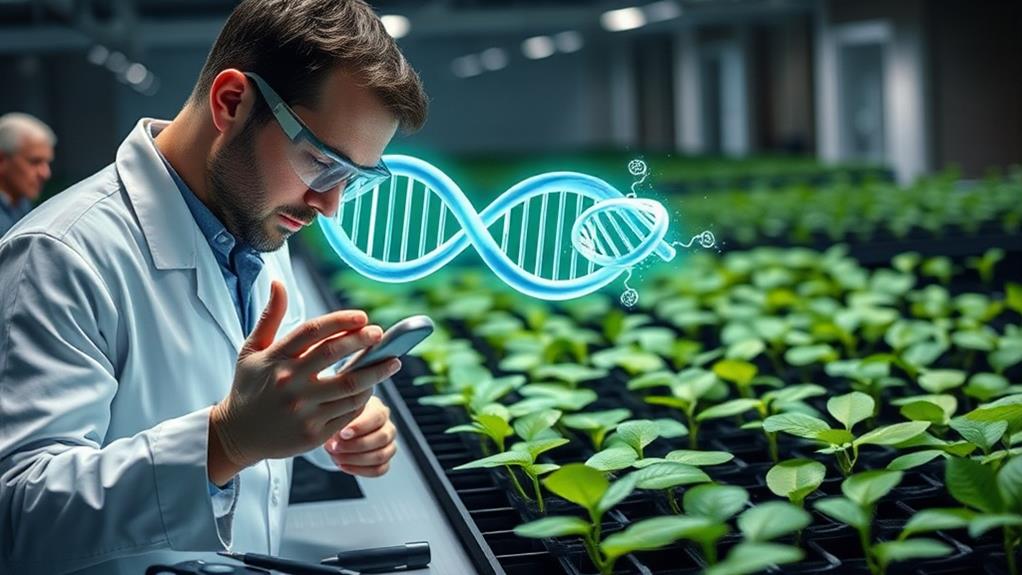DNA genetic engineering methods raise significant ethical concerns you should be aware of. These include animal welfare issues in research, potential environmental impacts on biodiversity, and challenges with informed consent in human applications. You'll find that societal inequality and access to genetic technologies are major concerns, as is the risk of unintended consequences from genetic modifications. Regulatory bodies struggle to keep pace with rapidly evolving techniques, leading to inconsistent oversight across countries. As these methods continue to advance, it's vital to reflect on the ethical implications and potential risks associated with genetic engineering. Exploring these issues further will provide a deeper understanding of the complexities involved.
Animal Welfare Concerns
While genetic engineering has opened new frontiers in scientific research, it has raised significant animal welfare concerns. The creation of genetically engineered animals has led to new ethical challenges, particularly in research settings. These animals are often classified under Category D procedures, indicating they may experience moderate to severe pain throughout their lives.
Additionally, the implications of genetic modifications can affect biological relationships and species integrity, as seen in the applications of DNA testing for family lineage exploration.
You'll find that genetic engineering procedures can have unintended consequences on animal behavior and welfare. The techniques used, such as transgenesis and gene manipulation, may affect an animal's intrinsic value and species integrity. It's essential to recognize that these procedures have high failure rates, with only 1% to 30% of embryos carrying desired alterations. This necessitates continuous monitoring of genetically engineered animals due to unpredictable welfare impacts.
Cloning technologies present additional ethical concerns, including developmental abnormalities and long-term welfare implications for the animals produced. The increase in genetically engineered animals has complicated efforts to implement the Three Rs principle (Reduction, Refinement, Replacement), which aims to minimize animal suffering in research.
As you consider these issues, it's clear that balancing scientific progress with animal welfare remains a significant challenge in the field of genetic engineering.
Environmental Impact and Biodiversity
Beyond the concerns surrounding animal welfare, genetic engineering poses significant challenges to environmental stability and biodiversity. The widespread adoption of genetically modified crops has led to increased monoculture practices, potentially reducing the variety of plant species in agricultural areas. This shift can have far-reaching consequences on local ecosystems, as genetically engineered organisms may disrupt natural selection processes and impact non-target species.
Environmental assessments are vital to understanding the long-term effects of genetic engineering on biodiversity. Scientists have identified several potential risks, including:
- The creation of "superweeds" through cross-breeding with wild relatives
- Unintended harm to beneficial insects and soil microorganisms
- Alterations in food webs and ecosystem dynamics
The introduction of genetically engineered animals into agriculture raises additional ethical concerns about their potential impact on wildlife if they escape into natural habitats. These concerns highlight the need for thorough studies on the ecological implications of genetic engineering.
As we continue to explore the possibilities of DNA manipulation, it's critical to evaluate the delicate balance of our ecosystems.
Careful monitoring and regulation of genetically engineered organisms are necessary to prevent ecological imbalances and preserve biodiversity for future generations.
Consent and Human Applications
The complex landscape of genetic engineering extends far beyond environmental concerns, touching on deeply personal and ethical issues in human applications.
When it comes to genetic modifications, particularly germline editing, the concept of informed consent becomes incredibly intricate. You're faced with ethical dilemmas surrounding the decision-making process for future generations who'll be affected by these interventions.
As a prospective parent, you might be confronted with choices similar to those in preimplantation genetic diagnosis. However, the unknown risks of germline editing complicate the idea of informed consent. It's essential that you understand the potential risks and benefits associated with genetic modifications. This understanding is significant for public health and the development of ethical guidelines.
The use of embryos in genetic editing research further complicates matters. You'll find varying regulations across countries regarding their utilization, highlighting the need for clear ethical frameworks.
As genome editing technologies advance, it's important to take into account public objections and guarantee that consent processes in human applications are governed by robust regulatory standards.
Societal Inequality and Access
When considering the ethical implications of genetic engineering, you'll find that unequal technology distribution is a significant concern.
You may observe that socioeconomic barriers could limit access to genetic enhancements, potentially creating new social divisions based on genetic modifications.
It's important to recognize that without proper policies and regulations, these advanced technologies might exacerbate existing healthcare disparities, further widening the gap between different socioeconomic groups.
Unequal Technology Distribution
Addressing the issue of unequal technology distribution in genetic engineering reveals a stark divide between those who can access these groundbreaking advancements and those who can't.
As genetic engineering technologies like CRISPR become more prevalent, you'll likely see a growing gap in health care access. This disparity could lead to significant differences in health outcomes, with wealthy individuals potentially benefiting from genetic enhancements while others are left behind.
The uneven distribution of genome editing technologies raises serious ethical considerations. You might witness:
- A new social class emerging based on genetic modifications
- Increased health disparities between affluent and low-income populations
- Geographic inequalities in access to treatments for genetic disorders
Current regulatory frameworks vary widely across countries, further complicating equal access to these advancements.
The high cost of genetic engineering procedures may limit their availability to lower-income individuals and communities. To address these concerns, it's essential to develop policies that guarantee fair access to emerging genome editing technologies.
Without such measures, you'll likely see an entrenchment of health disparities based on socioeconomic status, potentially widening the gap between the genetically enhanced and unmodified populations.
Socioeconomic Access Barriers
Socioeconomic barriers to genetic engineering technologies present a troubling ethical dilemma. You'll find that limited access to these advanced treatments often stems from socioeconomic disparities, with wealthier individuals more likely to benefit from gene therapies and genetic testing.
This situation exacerbates existing healthcare inequities, as lower-income populations struggle to access potentially life-saving interventions due to high costs.
Ethical concerns arise from the potential creation of "genetic classes," where only affluent individuals can enhance or prevent genetic disorders. This widening gap in health outcomes between socioeconomic groups is further complicated by the concentration of genetic health services in urban areas, leaving rural populations with fewer options.
To address these issues, you'll need to reflect on policies aimed at equitable distribution of genetic engineering advancements.
These policies are crucial to prevent the worsening of health disparities and guarantee that all socioeconomic groups can benefit from these innovations. By focusing on fair access to genetic technologies, we can work towards a future where the potential benefits of DNA engineering are available to everyone, regardless of their economic status.
Unintended Consequences and Risks
When you consider genetic engineering, you need to be aware of potential unintended consequences. Off-target genetic modifications can occur, where changes are made to unintended parts of the genome, potentially leading to unforeseen health issues or behavioral changes in engineered organisms.
Additionally, the release of genetically modified organisms into the environment can disrupt ecological balance, as altered genes may spread to wild populations and affect biodiversity.
Off-Target Genetic Modifications
Maneuvering the unpredictable terrain of off-target genetic modifications presents one of the most significant challenges in DNA genetic engineering. When you're working with genome editing tools like CRISPR, unintended modifications can occur in up to 20% of cases.
These off-target effects may lead to genetic diseases or malformations in edited organisms, raising serious ethical implications.
You should be aware that off-target modifications can result in:
- Unexpected changes in an organism's traits
- Potential health issues due to mosaicism
- Unforeseen ecological impacts if released into the environment
Safety assessments are imperative before any clinical applications of genetic engineering. Regulatory agencies require thorough evaluations of the specificity and efficiency of genetic modifications to minimize risks.
The potential for unintended modifications in the germ line, which could be passed down to future generations, further complicates the ethical landscape.
As you consider the future of genome editing, it's important to weigh the benefits against the risks. Ongoing research and public discourse are essential to guarantee that genetic engineering advances don't compromise animal welfare or ecological balance.
The unpredictability of off-target effects underscores the need for continued vigilance and improvement in DNA engineering methods.
Ecological Balance Disruption
The ecological balance hangs in a precarious state when it comes to DNA genetic engineering. You'll find that genetically modified organisms (GMOs) can inadvertently disrupt local ecosystems and biodiversity by outcompeting native species. This imbalance can lead to unforeseen consequences in food production and overall environmental health.
Genetic engineering techniques, like genome editing, may result in unintended off-target effects. These can cause unpredictable changes in an organism's genome, potentially altering its interaction with the environment.
You should be aware that the widespread use of genetically modified crops has been linked to declining insect populations, including beneficial pollinators. This can have cascading effects on food systems and ecosystem health.
Additionally, you'll notice that the potential for gene transfer between engineered crops and wild relatives can create herbicide-resistant "superweeds," leading to increased pesticide use.
The reliance on a few genetically engineered crop varieties also reduces genetic diversity, making ecosystems more vulnerable to diseases and pests. This loss of diversity ultimately threatens food security and ecological stability, highlighting the complex ethical issues surrounding DNA genetic engineering methods.
Regulatory Challenges and Oversight
Faced with rapidly evolving genetic engineering technologies, regulatory bodies worldwide are struggling to keep pace. The inconsistency in regulatory oversight across countries has led to varying safety standards and ethical guidelines for gene editing. In the U.S., the Coordinated Framework for the Regulation of Biotechnology oversees genetic engineering, but it's often outpaced by emerging technologies.
Key regulatory bodies involved in genetic engineering oversight include:
- The FDA, with its voluntary Plant Biotechnology Consultation Program
- The EPA, evaluating environmental impacts
- The USDA, focusing on agricultural applications
These agencies work to guarantee public health and safety, but concerns persist about the adequacy of existing regulations. As a result, there's ongoing discussion about updating frameworks to address potential risks associated with genetic engineering.
International efforts to harmonize genome editing regulations began in December 2015, highlighting the need for global ethical guidelines and safety standards. These initiatives aim to create a more consistent approach to regulating genetic engineering worldwide.
As technologies continue to advance, it's essential to strike a balance between fostering innovation and maintaining rigorous oversight to protect public health and the environment.
Conclusion
As you've learned, DNA genetic engineering raises complex ethical issues. By coincidence, these challenges mirror many broader societal concerns. You'll need to weigh the potential benefits against risks to animal welfare, the environment, and human rights. It's vital that you stay informed about regulatory developments and scientific advancements in this field. While the technology offers exciting possibilities, it's important to approach its applications thoughtfully, considering both short-term gains and long-term consequences for individuals and society.


